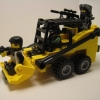-
Posts
2,501 -
Joined
-
Last visited
About wpirobotbuilder
- Birthday Apr 17, 1991
Contact Methods
-
Steam
wpirobotbuilder
-
Battle.net
Greenspawn
-
Twitter
wpirobotbuilder
Profile Information
-
Gender
Male
-
Location
Massachusetts
-
Interests
Robots, Computers (obviously), Rowing, Bicycling, Hiking, Gardening, Programming
-
Biography
I received a Bachelor of Science in both Robotics Engineering and Electrical/Computer Engineering, and a Master of Science in Robotics Engineering. I'm a robot guy.
My work in Robotics has primarily been focused on assistive technologies, and has won multiple awards, including one from Intel's annual Cornell Cup USA. Going forward with my Master's degree I may continue down that path, but I'm not entirely sure yet.
I currently work in robotics and large-scale computing infrastructure, primarily for robotic warehouses. If you've ever purchased something from Amazon, you're welcome.
I didn't know anything about building computers before I started watching Linus's videos. When interviewing at Intel I didn't know what a PCI-E bus was or what SATA was. Once I stopped Rowing to focus on school, I also started learning about computers to pass my free time. I started watching Linus's videos religiously, watching older ones over and over to learn all the details possible. In July 2013 I finally got to put my knowledge into action, designing a workstation for a friend and a small server for myself. Both systems were successful and both of us were satisfied. -
Occupation
Full-time Engineer
-
Member title
Robot Builder
System
-
CPU
Intel i7 4790K @ 4.4/4.4/4.4/4.4
-
Motherboard
MSI Z97 MPOWER
-
RAM
Corsair Vengeance LP 16GB
-
GPU
R9 290 Trifire
-
Case
Phanteks Enthoo Pro
-
Storage
Crucial MX100 256GB
-
PSU
EVGA G2 1300W
-
Display(s)
HP 2009m, HP W2073a
-
Cooling
NH-D15
-
Keyboard
Generic HP Keyboard
-
Mouse
Generic HP Mouse
-
Sound
Onboard
-
Operating System
Windows 8.1
Recent Profile Visitors
The recent visitors block is disabled and is not being shown to other users.
wpirobotbuilder's Achievements
-

Flashing IBM ServeRaid M1015
wpirobotbuilder replied to ERSCreeper's topic in Servers, NAS, and Home Lab
@alpenwasser wrote a great tutorial a number of years ago -- -

How To: Choosing Your Storage Devices and Configuration
wpirobotbuilder replied to wpirobotbuilder's topic in Storage Devices
Any brand is fine, the two most popular I know of are Western Digital and Seagate. The WD Blue, or the Seagate Desktop drives are good choices. -

really odd raid setup, could this at least function.
wpirobotbuilder replied to Sion_the_Rapadant's topic in Storage Devices
That's only doable with software RAID. You'd have to get them all to appear as writable volumes (you can see this in Disk Management), then use something like Windows Storage Spaces to bind them together. What specifically are you going for? If you want as much capacity as possible, it would make more sense to just use SATA SSDs and get a PCIe RAID controller -- It'll be easier to manage, and likely less expensive -

How To: Choosing Your Storage Devices and Configuration
wpirobotbuilder replied to wpirobotbuilder's topic in Storage Devices
I would paste this question as a new thread in the Storage section of the forum. -

RAID Storage Solution - Video Editing & Caching
wpirobotbuilder replied to Strikermed's topic in Storage Devices
I haven't used a 9266 card before, if the cache is onboard then you can't swap it out (I believe there are some cards which you can add caching to later on). 1GB of cache is probably the biggest you'll find on a reasonably priced card, since it's basically just DDR2/3 ram chips on there. I'm not sure if you'll see a benefit to performance, I would turn off hyperthreading, then run your workflow, and see if your CPU usage is 90% or higher (whereas before, with hyperthreading on, you would see 60%). If this is true, then you are maxing out the physical cores -- no amount of threading can get you more processing. If this is not true, then your CPU may not be the bottleneck. Did you try this, and what did you see? -

RAID Storage Solution - Video Editing & Caching
wpirobotbuilder replied to Strikermed's topic in Storage Devices
If you are running with hyper threading turned on, your CPU percentage might only hit 60% as reported by Task Manager, but the underlying cores will be maxed out. I found this out when playing Cities Skylines, trying to diagnose why my simulation wouldn't run much faster than 1x speed. Try turning off hyper-threading and run your editing workflow again, see if you hit 100%. It's entirely possible that Adobe's file access patterns are different when you have multiple clips in the same project. In this case, it is the software that is the problem. If you're editing on hard drives, you will definitely feel the pain, because the cost of changing the read location is very high. An SSD would help mitigate this, but given the files you're working with and your budget, that may or may not be feasible. You mention that you have an LSI-9266, do you have an onboard cache for the RAID controller? They sell them on the side, and they dramatically improve performance for non-sequential access patterns. -

can i set up cloud computing like this?
wpirobotbuilder replied to carguy86's topic in Servers, NAS, and Home Lab
Can you specify exactly what you want to do? You mentioned F@H, but there are other things you can do with those machines. Cloud computing and clustering are not the same thing, though clustering can be used for some cloud applications. For instance, if you want a gaming service that allows you to stream games to a client (Steam, for instance), you could put a GPU into your 24g server and host an OS that supports streaming. That's a version of cloud computing -- you've offloaded the processing from the client. However, if you want a redundant game streaming service that doesn't get interrupted if a component fails, you will need to have some sort of failover mechanism, or you'd need to make the service distributed. Both are difficult to achieve, and you won't find it easily accessible outside of the enterprise space. -

Best CPU for a NAS with FreeNAS
wpirobotbuilder replied to TDA's topic in Servers, NAS, and Home Lab
The aforementioned i3 or Pentium would be good. Alternatively, you can get a lot of processing power for your money if you buy used server hardware. For instance, I got two 6-core Xeons for about $130, plus a used server motherboard. It does require doing research to make sure everything's compatible. -

How To: Choosing Your Storage Devices and Configuration
wpirobotbuilder replied to wpirobotbuilder's topic in Storage Devices
It provides no benefit, and slightly harms the SSD. -

How To: Choosing Your Storage Devices and Configuration
wpirobotbuilder replied to wpirobotbuilder's topic in Storage Devices
You should not run defragment an SSD, there is no real need to, and it shortens the lifespan of the drive. Defragmentation was invented for mechanical hard drives, where read performance is very good when all the bytes for your files are stored together, in order. There are some other benefits to defragmentation on hard drives, such as better usage of the amount of storage on disk, but I would say they're less important than the performance. Generally, your files are written as a set of contiguous bytes, however modification of the files may require putting different parts of the file in different places. When you later want to read that file, your hard drive cannot read the whole file as a single operation, so it must perform multiple reads on different parts of the disk, lowering your read performance. SSDs do not have this problem because it takes the same amount of time to read from every cell regardless of its physical location. Defragmenting will not give any performance benefits. Additionally, because defragmentation does a lot of physical data moving, you will perform lots of write and erase operations, which reduce the lifespan of the SSD. -
I would recommend passing a physical NIC directly to your Pfsense VM to use as your WAN port. That way all network traffic goes through Pfsense, guaranteed, and none of it is touched by the Hypervisor. This article lists a few reasons why it's not a great idea to virtualize Pfsense, personally I think it's ok in a home environment but I would at the very least use a physical NIC to your VM -- https://forum.pfsense.org/index.php?topic=1009.0.
-
The cheapest you can get is a prebuilt, depending on the number of drives. Here's one for $100 USD -- http://www.amazon.com/Synology-DiskStation-Diskless-Attached-DS210j/dp/B002XQ3C0E. It's really hard to beat that with computer parts, unless you have an old computer lying around. However, if you have many hard drives the prebuilt NAS units tend to have more features, some of which aren't always useful to the consumer, and cost more -- see this one, for example. In this case, building your own makes economic sense.
-
How many hard drives are you using? Do you plan to run a RAID setup, or do you just need SATA ports? If you want to run a RAID1 or RAID 10, then the onboard controller should be okay for your needs. If you're going to use RAID5, a dedicated PCI controller is recommended, and for RAID6 it is required.
-
You can pass through devices to ESXi, but not keyboards and mice. You'd have to pass through a USB controller to the VM. However, passing through chipset USB is difficult to do, so the general recommendation is to get PCIe USB cards and pass them through directly to your VMs. Nvidia cards generally don't support PCIe passthrough on ESXi, AMD cards tend to work (except dual-GPU). Puget Systems built a setup like you're describing, you can see instructions https://www.pugetsystems.com/labs/articles/Multi-headed-VMWare-Gaming-Setup-564/here Here's a blog that describes a lot about setting up this kind of stuff - http://thehomeserverblog.com/esxi/esxi-5-0-amd-whitebox-server-for-500-with-passthrough-iommu-build-2/
















